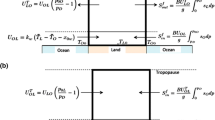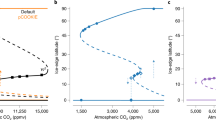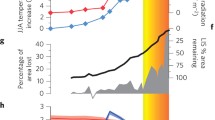Abstract
The hard snowball Earth bifurcation point is determined by the level of atmospheric carbon dioxide concentration (pCO2) below which complete glaciation of the planet would occur. In previous studies, the bifurcation point was determined based on the assumption that the extent of continental glaciation could be neglected and the results thereby obtained suggested that very low values of pCO2 would be required (~100 ppmv). Here, we deduce the upper bound on the bifurcation point using the coupled atmosphere–ocean climate model of the NCAR that is referred to as the Community Climate System Model version 3 by assuming that the continents are fully covered by ice sheets prior to executing the transition into the hard snowball state. The thickness of the ice sheet is assumed to be that obtained by an ice-sheet model coupled to an energy balance model for a soft snowball Earth. We find that the hard snowball Earth bifurcation point is in the ranges of 600–630 and 300–320 ppmv for the 720 and 570 Ma continental configurations, respectively. These critical points are between 10 and 3 times higher than their respective values when ice sheets are completely neglected. We also find that when the ice sheets are thinner than those assumed above, the climate is colder and the bifurcation point is larger. The key process that causes the excess cooling when continental ice sheets are thin is shown to be associated with the fact that atmospheric heat transport from the adjacent oceans to the ice sheet-covered continents is enhanced in such conditions. Feedbacks from sea-ice expansion and reduced water vapor concentration further cool the oceanic regions strongly.












Similar content being viewed by others
References
Ackerman SA, Strabala KI, Menzel WP, Frey RA, Moeller CC, Gumley LE (1998) Discriminating clear sky from clouds with MODIS. J Geophys Res Atmos 103(D24):32141–32157. doi:10.1029/1998jd200032
Bahcall JN, Pinsonneault MH, Basu S (2001) Solar models: current epoch and time dependences, neutrinos, and helioseismological properties. Astrophys J 555(2):990–1012. doi:10.1086/321493
Bodiselitsch B, Koeberl C, Master S, Reimold WU (2005) Estimating duration and intensity of Neoproterozoic snowball glaciations from Ir anomalies. Science 308(5719):239–242. doi:10.1126/science.1104657
Briegleb BP, Bitz CM, Hunke EC, Lipscomb WH, Holland MM, Schramm JL, Moritz RE (2004) Scientific description of the sea ice component in the Community Climate System Model, version three. NCAR technical note NCAR/TN-463 + STR:78. doi:10.5065/D6HH6H1P
Cess RD, Potter GL, Blanchet JP, Boer GJ, Delgenio AD, Deque M, Dymnikov V, Galin V, Gates WL, Ghan SJ, Kiehl JT, Lacis AA, Letreut H, Li ZX, Liang XZ, Mcavaney BJ, Meleshko VP, Mitchell JFB, Morcrette JJ, Randall DA, Rikus L, Roeckner E, Royer JF, Schlese U, Sheinin DA, Slingo A, Sokolov AP, Taylor KE, Washington WM, Wetherald RT, Yagai I, Zhang MH (1990) Intercomparison and interpretation of climate feedback processes in 19 atmospheric general-circulation models. J Geophys Res Atmos 95(D10):16601–16615. doi:10.1029/Jd095id10p16601
Chandler MA, Sohl LE (2000) Climate forcings and the initiation of low-latitude ice sheets during the Neoproterozoic Varanger glacial interval. J Geophys Res Atmos 105(D16):20737–20756. doi:10.1029/2000jd900221
Collins WD, Bitz CM, Blackmon ML, Bonan GB, Bretherton CS, Carton JA, Chang P, Doney SC, Hack JJ, Henderson TB, Kiehl JT, Large WG, McKenna DS, Santer BD, Smith RD (2006) The community climate system model version 3 (CCSM3). J Clim 19(11):2122–2143. doi:10.1175/Jcli3761.1
Crowley TJ, Hyde WT, Peltier WR (2001) CO2 levels required for deglaciation of a “near-snowball” Earth. Geophys Res Lett 28(2):283–286. doi:10.1029/2000gl011836
Dalziel IWD (1997) Neoproterozoic–Paleozoic geography and tectonics: review, hypothesis, environmental speculation. Geol Soc Am Bull 109(1):16–42
Donnadieu Y, Fluteau F, Ramstein G, Ritz C, Besse J (2003) Is there a conflict between the Neoproterozoic glacial deposits and the snowball Earth interpretation: an improved understanding with numerical modeling. Earth Planet Sci Lett 208(1–2):101–112. doi:10.1016/S0012-821x(02)01152-4
Donnadieu Y, Ramstein G, Fluteau F, Roche D, Ganopolski A (2004) The impact of atmospheric and oceanic heat transports on the sea-ice-albedo instability during the Neoproterozoic. Clim Dyn 22(2–3):293–306. doi:10.1007/S00382-003-0378-5
Feulner G, Kienert H (2014) Climate simulations of Neoproterozoic snowball Earth events: similar critical carbon dioxide levels for the Sturtian and Marinoan glaciations. Earth Planet Sci Lett 404:200–205. doi:10.1016/J.Epsl.2014.08.001
Fiorella RP, Poulsen CJ (2013) Dehumidification over tropical continents reduces climate sensitivity and inhibits snowball Earth initiation. J Clim 26(23):9677–9695. doi:10.1175/Jcli-D-12-00820.1
Gough DO (1981) Solar interior structure and luminosity variations. Sol Phys 74(1):21–34. doi:10.1007/Bf00151270
Heinemann M, Jungclaus JH, Marotzke J (2009) Warm Paleocene/Eocene climate as simulated in ECHAM5/MPI-OM. Clim Past 5(4):785–802
Hoffman PF, Li ZX (2009) A palaeogeographic context for Neoproterozoic glaciation. Palaeogeogr Palaeoclimatol 277(3–4):158–172. doi:10.1016/J.Palaeo.2009.03.013
Hoffman PF, Schrag DP (2000) Snowball earth. Sci Am 282(1):68–75
Hoffman PF, Schrag DP (2002) The snowball Earth hypothesis: testing the limits of global change. Terra Nova 14(3):129–155
Hoffman PF, Kaufman AJ, Halverson GP, Schrag DP (1998) A Neoproterozoic snowball earth. Science 281(5381):1342–1346
Hoffman PF, Halverson GP, Domack EW, Husson JM, Higgins JA, Schrag DP (2007) Are basal Ediacaran (635 Ma) post-glacial “cap dolostones” diachronous? Earth Planet Sci Lett 258(1–2):114–131. doi:10.1016/J.Epsl.2007.03.032
Hyde WT, Crowley TJ, Baum SK, Peltier WR (2000) Neoproterozoic ‘snowball Earth’ simulations with a coupled climate/ice-sheet model. Nature 405(6785):425–429
Jenkins GS, Smith SR (1999) GCM simulations of snowball Earth conditions during the late Proterozoic. Geophys Res Lett 26(15):2263–2266. doi:10.1029/1999gl900538
Kahl JD (1990) Characteristics of the low-level temperature inversion along the Alaskan Arctic coast. Int J Climatol 10(5):537–548. doi:10.1002/Joc.3370100509
Lewis JP, Weaver AJ, Eby M (2007) Snowball versus slushball Earth: dynamic versus nondynamic sea ice? J Geophys Res Oceans. doi:10.1029/2006jc004037
Li ZX, Bogdanova SV, Collins AS, Davidson A, De Waele B, Ernst RE, Fitzsimons ICW, Fuck RA, Gladkochub DP, Jacobs J, Karlstrom KE, Lu S, Natapov LM, Pease V, Pisarevsky SA, Thrane K, Vernikovsky V (2008) Assembly, configuration, and break-up history of Rodinia: a synthesis. Precambrian Res 160(1–2):179–210. doi:10.1016/J.Precamres.2007.04.021
Liu Y, Peltier WR (2010) A carbon cycle coupled climate model of Neoproterozoic glaciation: influence of continental configuration on the formation of a “soft snowball”. J Geophys Res Atmos. doi:10.1029/2009jd013082
Liu Y, Peltier WR (2011) A carbon cycle coupled climate model of Neoproterozoic glaciation: explicit carbon cycle with stochastic perturbations. J Geophys Res Atmos. doi:10.1029/2010jd015128
Liu Y, Peltier WR (2013a) Sea level variations during snowball Earth formation and evolution: 2. The influence of Earth’s rotation. J Geophys Res Solid Earth 118:1–21. doi:10.1002/jgrb.50294
Liu Y, Peltier WR (2013b) Sea level variations during snowball Earth formation: 1. A preliminary analysis. J Geophys Res 118:1–15. doi:10.1002/jgrb.50293
Liu Y, Peltier WR, Yang J, Vettoretti G (2013) The initiation of Neoproterozoic “snowball” climates in CCSM3: the influence of paleocontinental configuration. Clim Past 9:2555–2577. doi:10.5194/cp-9-2555-2013
Macdonald FA, Schmitz MD, Crowley JL, Roots CF, Jones DS, Maloof AC, Strauss JV, Cohen PA, Johnston DT, Schrag DP (2010) Calibrating the Cryogenian. Science 327:1241–1243. doi:10.1126/science.1183325
Oleson KW, Dai Y, Bonan G, Bosilovich M, Dickinson RE, Dirmeyer P, Hoffman F, Houser P, Levis S, Niu G-Y, Thornton P, Vertenstein M, Yang Z-L, Zeng X (2004) Technical description of the Community Land Model (CLM). NCAR Technical Note NCAR/TN-495 + STR:174. doi:10.5065/D6N877R0
Peltier WR, Liu YG, Crowley JW (2007) Snowball Earth prevention by dissolved organic carbon remineralization. Nature 450(7171):813–818. doi:10.1038/Nature06354
Pierrehumbert RT (2005) Climate dynamics of a hard snowball Earth. J Geophys Res Atmos. doi:10.1029/2004jd005162
Poulsen CJ, Jacob RL (2004) Factors that inhibit snowball Earth simulation. Paleoceanography. doi:10.1029/2004pa001056
Poulsen CJ, Pierrehumbert RT, Jacob RL (2001) Impact of ocean dynamics on the simulation of the Neoproterozoic “snowball Earth”. Geophys Res Lett 28(8):1575–1578. doi:10.1029/2000gl012058
Poulsen CJ, Jacob RL, Pierrehumbert RT, Huynh TT (2002) Testing paleogeographic controls on a Neoproterozoic snowball Earth. Geophys Res Lett. doi:10.1029/2001gl014352
Poulsen CJ, Tabor C, White JD (2015) Long-term climate forcing by atmospheric oxygen concentrations. Science 348(6240):1238–1241. doi:10.1126/science.1260670
Rodehacke CB, Voigt A, Ziemen F, Abbot DS (2013) An open ocean region in Neoproterozoic glaciations would have to be narrow to allow equatorial ice sheets. Geophys Res Lett 40(20):5503–5507. doi:10.1002/2013gl057582
Rosenbloom N, Shields CA, Brady E, Yeager S, Levis S (2011) Using CCSM3 for paleoclimate applications. NCAR Technical note NCAR/TN-483 + STR:81. doi:10.5065/D69S1P09
Shackleton NJ, Berger A, Peltier WR (1990) An alternative astronomical calibration of the lower pleistocene timescale based on ODP site 677. Trans R Soc Edinb Earth 81:251–261
Tarasov L, Peltier WR (1999) Impact of thermomechanical ice sheet coupling on a model of the 100 kyr ice age cycle. J Geophys Res Atmos 104(D8):9517–9545
Voigt A, Abbot DS (2012) Sea-ice dynamics strongly promote snowball Earth initiation and destabilize tropical sea-ice margins. Clim Past 8(6):2079–2092. doi:10.5194/Cp-8-2079-2012
Voigt A, Marotzke J (2010) The transition from the present-day climate to a modern Snowball Earth. Clim Dy 35(5):887–905. doi:10.1007/S00382-009-0633-5
Voigt A, Abbot DS, Pierrehumbert RT, Marotzke J (2011) Initiation of a Marinoan snowball Earth in a state-of-the-art atmosphere-ocean general circulation model. Clim Past 7(1):249–263. doi:10.5194/Cp-7-249-2011
Yang J, Peltier WR, Hu YY (2012a) The initiation of modern “soft snowball” and “hard snowball” climates in CCSM3. Part I: the influences of solar luminosity, CO2 concentration, and the sea ice/snow albedo parameterization. J Clim 25(8):2711–2736. doi:10.1175/Jcli-D-11-00189.1
Yang J, Peltier WR, Hu YY (2012b) The initiation of modern “soft snowball” and “hard snowball” climates in CCSM3. Part II: climate dynamic feedbacks. J Clim 25(8):2737–2754. doi:10.1175/Jcli-D-11-00190.1
Yang J, Peltier WR, Hu YY (2012c) The initiation of modern soft and hard Snowball Earth climates in CCSM4. Clim Past 8(3):907–918. doi:10.5194/Cp-8-907-2012
Acknowledgments
We thank Z.X. Li at Curtin University of Australia and W.T. Hyde for providing the continental boundary conditions that were used to construct the 720 and 570 Ma land–ocean masks, respectively. We are grateful to the three anonymous reviewers whose suggestions have improved both the presentation and the science content of the paper. The CCSM3 simulations were performed on the SciNet facility at the University of Toronto, which is a component of the Compute Canada HPC platform, while the CAM3 simulations were performed on the supercomputer at the LaCOAS facility of Peking University. Y. Liu is supported by the Startup Fund of the Ministry of Education of China. The research of WRP at the University of Toronto is supported by NSERC Discovery Grant A9627.
Author information
Authors and Affiliations
Corresponding author
Rights and permissions
About this article
Cite this article
Liu, Y., Peltier, W.R., Yang, J. et al. Strong effects of tropical ice-sheet coverage and thickness on the hard snowball Earth bifurcation point. Clim Dyn 48, 3459–3474 (2017). https://doi.org/10.1007/s00382-016-3278-1
Received:
Accepted:
Published:
Issue Date:
DOI: https://doi.org/10.1007/s00382-016-3278-1




